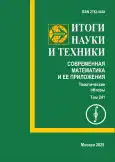Том 241 (2025)
Статьи
Критерии устойчивости систем нелинейных обыкновенных дифференциальных уравнений на основе аддитивных преобразований формулы конечных приращений
Аннотация
 3-12
3-12


О максимальном числе остовных деревьев в кактусах с заданным числом вершин
Аннотация
 13-17
13-17


Позиционный принцип минимума в задачах оптимального управления с терминальными ограничениями и его расширения
Аннотация
 18-29
18-29


Вероятностные распределения, задаваемые с помощью чисел Лаха и обобщенных чисел Лаха
Аннотация
 30-39
30-39


Применение метода параметризации для решения задач оптимального управления с разрывами фазовой траектории
Аннотация
 40-54
40-54


Потери энергии быстрой цветной частицы в неабелевой плазме в рамках гамильтонова формализма
Аннотация
 55-63
55-63


Параметрическая трансформация невыпуклых задач оптимального управления
Аннотация
 64-70
64-70


Об одном $SI^{\ast}$-интервале мультиопераций ранга $2$
Аннотация
Рассматриваются мультиоперации ранга $2$ с суперпозицией, определенной на основе теоретико-множественной операции пересечения с выделением одного элемента. Описан интервал между клоном самодвойственных операций и мультиклоном всех мультиопераций. Полученные результаты могут быть применены при изучении других интервалов в решетке мультиклонов ранга $2$.
 71-82
71-82


Первая краевая задача для некоторых смешанных уравнений теплопроводности второго и четвертого порядков
Аннотация
 83-89
83-89


Обобщенные уравнения Навье—Стокса, ассоциированные с комплексом Дольбо
Аннотация
 90-100
90-100







